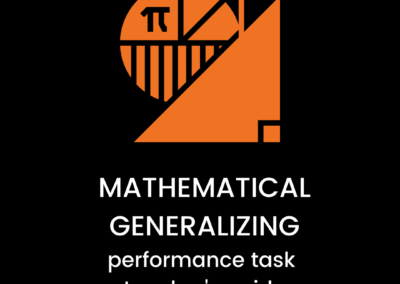
Description
The Mathematical Modeling Performance Task Guide introduces the steps to developing a mathematical model that presents real world, empirical data to support understanding and analysis, and to justifying the use of this model as appropriate within the problem context.
Creating and using models is fundamental to the study of mathematics. While mathematical models are often simple, the process of developing even basic models requires a great deal of thought and understanding, calling on both algorithms and hueristics. Mathematical modeling is a powerful performance task because it has applications not only in math, but across all the STEM subjects.
Opportunities for Student Choice
Student choice can be encouraged in a number of ways. Students can choose real-world phenomena to model, find or generate data, and choose to argue a specific position their model elucidates. If students are given the problem context and/or data, they can determine which model is appropriate to represent this data and discuss the affordances and limitations of their model. In some instances, they can also choose the resources they review, the data they will present, and/or the audience for their model.
Authentic Task
Creating and using models is fundamental to the study of mathematics. Models are used in almost all professions, including medicine, business, legal services, educational tools and services, engineering, news, and politics. They are used within these fields in various ways, including sales presentations, advertising, visual arguments, website design, presentations, and reporting.
Opportunities for Exhibition to an Audience
There are many possible audiences for mathematical models: simple graphs and charts can be created to help others understand complex data; Excel and CADD can be used to create virtual models of prototypes too costly to create; complex systems can be translated to mathematics to make predictions about likely outcomes of decisions.
Grade Level Exemplars/Models
3-4 Levels below High School:
- http://www.education.nh.gov/instruction/assessment/necap/released/documents/gr3_math_support12.pdf (see pages 21-24)
2 Levels below High School:
- http://www.education.nh.gov/instruction/assessment/necap/released/documents/gr7_math_support12.pdf (see pages 18-24)
High School:
Grade Level Adaptations
3-4 Levels below High School:
Student learning might focus on how to represent mathematical data in three samples charts, including a bar chart, a line chart, or a pie chart; and drawing out a position on their topic based on the data available.
2 Levels below High School:
Students will potentially be able to choose from a wide range of visual representations of data and be able to defend their visual choices based on the nature of the data and the point they are trying to portray. Students will also potentially focus learning on creating the most memorable and attractive representation of data towards furthering their main position.
High School:
Students might focus their learning on using larger data sets and more than one visual to display their data and support their position. Students will also potentially learn to adjust the visual representation of their data and position to engage and attract different audiences, as well as choose the most memorable visual representation.
Teacher Resources
General Information about Characteristics of Mathematical Models
- http://www.corestandards.org/Math/Content/HSM/
- http://www.pbslearningmedia.org/search/?q=*&selected_facets=supplemental_curriculum_hierarchy_nodes%3A1830&selected_facets=resource_distribution_type_exact%3A0
- http://map.mathshell.org/materials/stds.php?id=1164
A set of videos that explore traditional approaches to teaching mathematical modeling
- https://www.teachingchannel.org/videos/math-modeling-secondary-school-sbac
- https://www.teachingchannel.org/videos/distance-time-graph-lesson-sbac
- https://www.teachingchannel.org/videos/hs-math-teacher-collaboration-sbac
Dan Meyer, creator of Three Act Math, presents his remarks to the NCTM in 2014: “Fake-World Math—When Mathematical Modeling Goes Wrong and How to Get It Right”
In this video, Conrad Wolfram proposes approaching math as a four step process: posing the right questions; turning the real world into a math problem; computing; and turning the solution back to the real world to verify the formulation.
Formative Tasks















